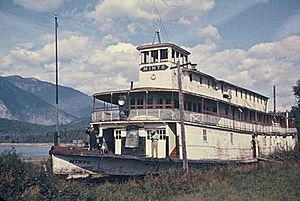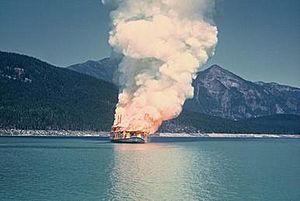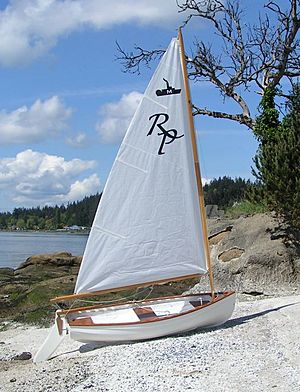Minto (sternwheeler) facts for kids
class="infobox " style="float: right; clear: right; width: 315px; border-spacing: 2px; text-align: left; font-size: 90%;"
| colspan="2" style="text-align: center; font-size: 90%; line-height: 1.5em;" | 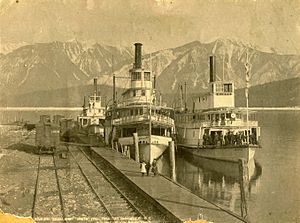
|}
The Minto was a special type of boat called a sternwheel steamboat. It sailed on the Arrow Lakes in British Columbia, Canada, from 1898 to 1954. During its many years of service, the Minto traveled over 3.2 million kilometers. It carried people and goods to small towns along the Arrow Lakes.
The Minto and its sister ship, the Moyie, were the very last sternwheelers to offer regular passenger service in the Pacific Northwest. A type of sailing dinghy (a small boat) called the "Minto" class was even named after this famous vessel.
Contents
| History | |
|---|---|
| Name | Minto |
| Owner | Canadian Pacific Railway |
| Route | Arrow Lakes |
| Builder | Thomas J. Bulger |
| Laid down | July 28, 1898 (assembly of pre-manufactured components began) |
| Launched | November 19, 1898, at Nakusp, BC |
| Maiden voyage | November 19, 1898 |
| In service | 1898 |
| Out of service | 1954 |
| Identification | CAN 107453 |
| Fate | Deliberately burned August 1968 after attempts at conversion to museum failed |
| Notes | near twin of Moyie |
| General characteristics | |
| Type | inland shallow-draft boat passenger/freighter |
| Tonnage | 829 gross; 522 net |
| Length | 161.7 ft (49 m) |
| Beam | 30.1 ft (9 m) |
| Depth | 5.1 ft (2 m) depth of hold |
| Ice class | steel-sided hull allowed some ice navigation |
| Installed power | coal-fired boiler generating steam at pressure of 175 lbs p.s.i., steam engines manufactured by Bertram Engineering Company of Toronto, Ontario, twin single-cylinder, horizontally mounted, 16" bore by 72" stroke, 17 horsepower nominal |
| Propulsion | sternwheel |
| Capacity | As of 1920: 13 staterooms, 400 passengers |
| Crew | As of 1920, total of 33: Master, mate, pilot, nine deckhands, two engineers, three firemen, one coal passer, purser, freight clerk, chief steward, eleven assistant stewards and cooks |
Building the Minto Steamboat
Designed for the Klondike Gold Rush
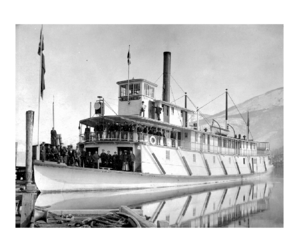
The Minto was one of three steamboats made from steel and wood. They were originally planned for use on the Stikine River during the Klondike Gold Rush. The other two boats were the Moyie and the Tyrrell.
The Canadian Pacific Railway (CPR) ordered these boats. They hoped to create an "All-Canada" route to the Yukon gold fields. This route would avoid other paths that usually went through places like Skagway or Dyea. All the parts for these steamboats were made in Toronto, Ontario. Then, they were shipped to Canada's west coast to be put together.
Changing Plans: The Arrow Lakes Assignment
The Stikine River route to the Klondike gold fields did not work out well. After only three months in 1898, the CPR had several steamboats, including the Minto (which was still in pieces), that needed new routes.
The CPR decided to assemble the Tyrrell in Vancouver. The Moyie was put together on Kootenay Lake. The Minto was assembled at the Bulger shipyard in Nakusp, on upper Arrow Lake. The Minto was needed on the Arrow Lakes because the CPR's large new steamboat, the Nakusp, had been destroyed by fire in 1897.
It's possible that some parts of the Moyie and Minto were put together in Vancouver before being shipped inland. A skilled steamboat captain named James W. Troup oversaw the building of these ships. He was the superintendent for the CPR's Lake and River service. The assembly of the Moyie began first in Nelson, BC. Then, the crew moved to Nakusp and started working on the Minto on July 26, 1898. It's said that each sternwheeler had about 1,000 different parts!
Strong Design for Tough Conditions
The hulls (bottom parts) of the Minto, Moyie, and Tyrrell were built with strong steel frames. They had a wooden bottom and steel sheets on the sides. This design helped the Minto handle icy conditions on the lake. It was much better than the older wooden-hulled boats like the Nakusp.
This allowed the Minto to operate later into the year. However, in very cold weather, an ice-breaking barge was sometimes pushed in front of it. The mix of steel and wood also made these boats last much longer than other boats on the Arrow and Kootenay Lakes. Wooden hulls would quickly get waterlogged and lose their strength, but the Minto and Moyie did not have this problem.
Life on the Arrow Lakes
Once the Minto was finished, the CPR had five sternwheelers on the Arrow Lakes. These included the new passenger boat Rossland, the Kootenay, and the older Trail and Lytton. They also had two steam tugboats.
The Minto, with its strong steel-sided hull, usually operated during the winter months. The wooden-hulled Rossland and Kootenay were used more in the summer. This was when there were more tourists and their hulls were not at risk from ice.
Adding More Cabins
The Minto and Moyie were almost identical when they were first built. The Moyie was only slightly bigger. But over the years, they became more different. For example, in the winter of 1909-1910, the Minto had more cabins added.
This involved making the "texas" longer. The "texas" was the name for the cabin area on the very top deck, also called the "hurricane" deck. Similar work was done on the Rossland and Kootenay the year before. Pictures of these boats can be dated by looking at how long their "texas" sections are. Adding cabins to the Minto cost $2,953.
Winter Journeys
Winter made it very hard for steamboats to operate on the Arrow Lakes. The Minto was the best boat in the fleet for these conditions. Sometimes, the ice on the upper lake could be 10 inches thick. In some winters, the Minto could not travel to lower Arrow Lake. The CPR would then use the steam propeller boat Columbia to take its place.
In the very cold winter of 1916, the Kootenay got stuck in the ice. It was at the southern end of the Narrows, between the upper and lower Arrow Lakes. The Minto, with its steel hull, was sent from Nakusp to pick up the Kootenay's passengers. Luckily, there weren't many. The Minto couldn't reach the Kootenay directly. But it got close enough for passengers to walk across the ice or along the shore to get to the Minto. The Kootenay eventually broke free, but its hull was permanently damaged.
Impact of World War I
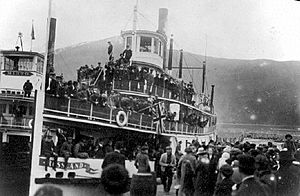
Business on the Arrow Lakes slowed down because of World War I. The war caused economic problems and a shortage of workers. Also, better train access to the area made steamboats less important. Many boats were taken out of service or were lost to fire or sinking and were not replaced.
The End of the Steamboat Era
By 1923, only two sternwheelers were still running on the Arrow Lakes: the very large Bonnington and the Minto. No new sternwheelers were built after 1914. However, the CPR did update the Minto. They added 20 new staterooms in 1920 and replaced its boiler in 1929.
The Great Depression and changes in how people traveled greatly affected the Arrow Lakes. After the summer of 1931, the Bonnington was taken out of service and docked at Nakusp. It never sailed again. This left only the Minto and the tugboat Columbia operating on the Arrow Lakes. In the summer, the Minto made the full trip through the lakes from Arrowhead to Robson and back. In the winter, the Minto worked on the upper lake, and the Columbia served the lower lake.
Still Sailing in the 1950s
Both the Minto and Moyie lasted for a very long time. They had a great crew who kept them in excellent condition. Some crew members had worked on the boats for many years. Walter Wright was the Mintos captain in the 1940s. He had started as a watchman on the Mintos very first trip in 1898!
While the Minto and Moyie continued to be important for transportation, they also became famous as a piece of living history. People who loved steamboats came from all over North America to ride them. The Saturday Evening Post magazine even wrote an article about the Minto. The National Film Board also made a movie about it.
In 1947, Professor Mills wrote about the Minto and Moyie:
That pair still survive, graying as they approach the half-century, but still doing their work, Moyie running from Proctor to Kaslo every Saturday, touching all the way landings informally, and bringing to little isolated lake settlements their mail, groceries, and visitors, stopping briefly to chat while the cargo is transferred, and going casually on. At noon everyone finds a place on deck, breaks out a lunch basket, and sets to, since the Moyie no longer has the refinement of a dining room. But Minto still has one and needs one, for her run is longer, the length of Arrow Lakes and a strip of the Columbia down to Robson, a trip lasting about two days. There were other stern-wheelers in the fleet, newer than the twins, but they did not have such powers of survival. Perhaps their names were too much for them -- Kooskanook, for example.
By 1954, out of all the steamboats that had ever run in British Columbia, Alaska, and the Pacific Northwest, only the Moyie and Minto were still offering regular passenger service. The CPR was losing $100,000 every year on its Arrow Lakes service. The docks at Nakusp and Robson also needed expensive repairs. The Minto itself would have needed $10,000 to pass its next safety inspection.
The Minto's Final Journey
On April 24, 1954, the Minto made its very last trip on the Arrow Lakes. By then, it had traveled an amazing 40.2 million kilometers during its time in service. That morning, the Minto left the dock at West Robson, BC on lower Arrow Lake. It was decorated with flags, and Captain Bob Manning was in command. There were 150 passengers on board, and all the staterooms were sold out. People came from all over British Columbia and beyond to ride the Minto one last time.
One special passenger was Mrs. Olivia Maitland. She had been on board the Minto fifty-six years earlier, on its very first voyage! Other officers on the last trip included Reg Barlow (second engineer), his son Fred Barlow (first officer), Lawrence Exton, and Jack Edmonds (purser).
Leaving Robson, the Minto stopped for the last time at all the small landings it had always served. At Syringa Creek, the retired postmaster, who had worked for 50 years, handed over the mail one last time. Then, he stood on the dock with his hat in his hand as the steamboat sailed away. At Edgewood, a crowd sang Auld Lang Syne. Across the lake at Fullmore Point, Jock Ford played a sad song on the bagpipes. Captain Manning even stopped the engines briefly so passengers could hear the music. At Burton, the townspeople placed a large cedar wreath on the Minto's front. At Arrowhead, a farmer named John Nelson put up a huge sign. It read: "Let us honor the brave pioneers of navigation on the scenic Arrow Lakes by making it possible to continue the very efficient services of the S.S. Minto." Similar scenes happened at other places along the route until the Minto returned to Nakusp for the final time.
Attempts to Save the Minto
The CPR no longer needed the Minto. They sold it to the city of Nakusp for just $1. The idea was to turn it into a museum. However, this plan never happened. In April 1956, the Minto was sold to a junk dealer in Nelson for $750.
The junk dealer took everything out of the Minto: the furniture, boilers, engines, and even the paddlewheel. Nothing was left but the empty hull and cabins. John Nelson, the farmer who had put up the sign, didn't have much money. But he still wanted to save the Minto. So, he bought what was left of it for $800. He had it towed to his farm near Galena Bay and pulled onto the shore. He tried to restore it, but because of his age and limited money, he couldn't make much progress.
The Final End
On November 26, 1967, John Nelson passed away at 88 years old. The Minto did not last much longer after him. Far down the lakes, a huge dam called the Keenleyside Dam was being built. It would be 170 feet tall. When finished, it would raise the water levels of all the lakes. This would flood the Narrows between the upper and lower Arrow Lakes. It would also submerge many towns and landings along the shore under as much as 40 feet of water.
BC Hydro, the company building the dam, offered to move and restore the Minto. But only if someone else paid the cost, which was estimated at $100,000. John Nelson's son, Walter, didn't have the money. Also, the Minto was in very bad condition after being out of service for over ten years. It didn't seem worth trying to save it anymore.
On August 1, 1968, the Minto was towed out into the lake to be deliberately burned. Walter Nelson, the son of its last owner, lit the match to set the boat on fire. In just a few minutes, the upper parts of the vessel were destroyed by the flames. The hull was later sunk.
The Minto Sailing Dinghy Class
Even though the sternwheeler was gone, the name "Minto" lived on. The "Minto" class of sailing dinghies were built in the 1950s and 1960s. The shape of these small boats was supposedly inspired by a lifeboat that was carried on board the steamer Minto. To remember this, the symbol on the sail of these dinghies is a sternwheel steamboat.


